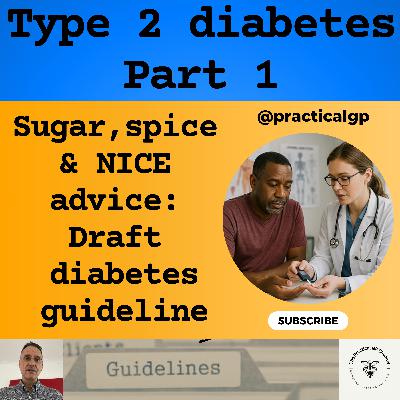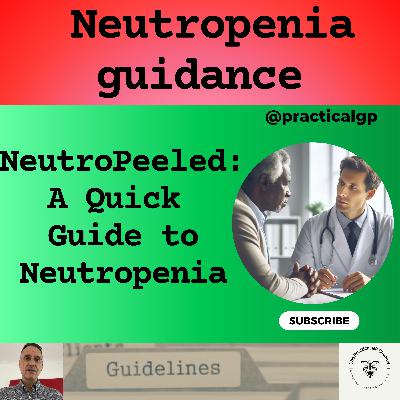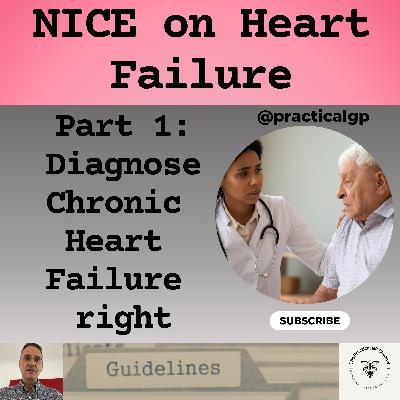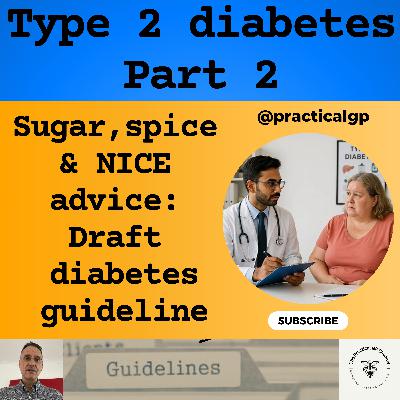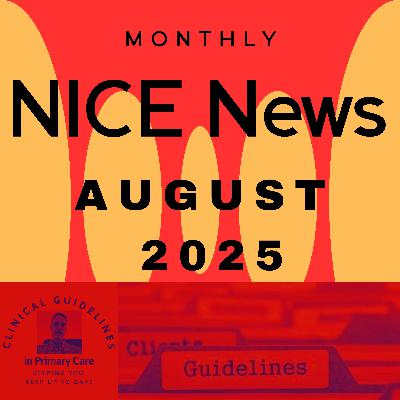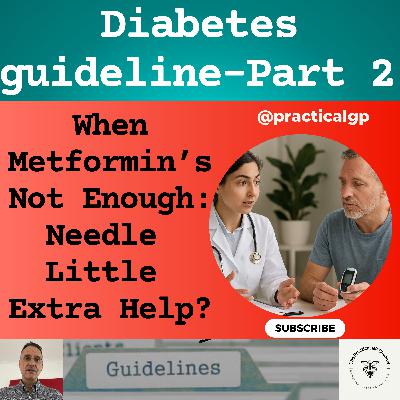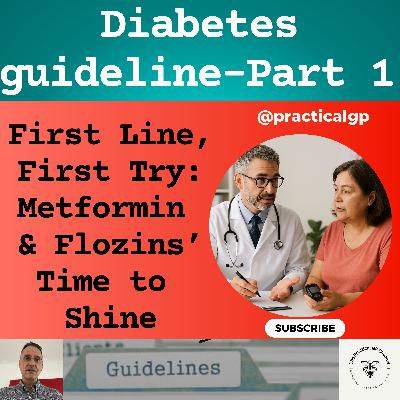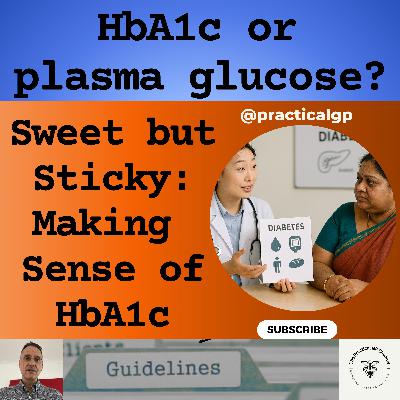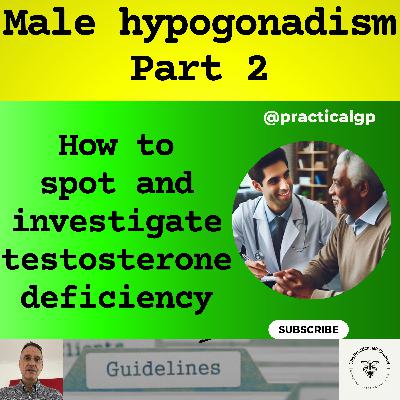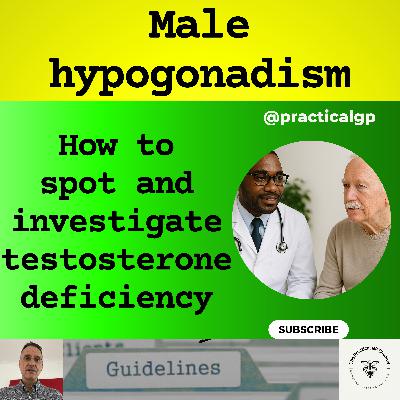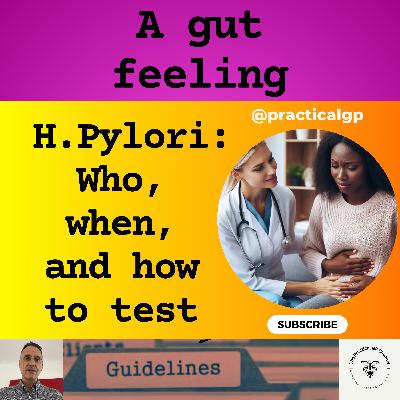Podcast - Sugar, Spice & NICE Advice: The Draft NICE Guideline on Type 2 Diabetes- Part 1
Description
The video version of this podcast can be found here:
· https://youtu.be/xB8BStN4Owg
This episode makes reference to guidelines produced by the "National Institute for Health and Care Excellence" in the UK, also referred to as "NICE". The content on this channel reflects my professional interpretation/summary of the guidance and I am in no way affiliated with, employed by or funded/sponsored by NICE.
NICE stands for "National Institute for Health and Care Excellence" and is an independent organization within the UK healthcare system that produces evidence-based guidelines and recommendations to help healthcare professionals deliver the best possible care to patients, particularly within the NHS (National Health Service) by assessing new health technologies and treatments and determining their cost-effectiveness; essentially guiding best practices for patient care across the country.
My name is Fernando Florido and I am a General Practitioner in the United Kingdom. In this episode I go through the draft NICE guideline on type 2 diabetes, which is open for public consultation until October 2025, and the final guidance being due in February 2026. Today’s episode is based on the NICE visual summary and the link to it is below.
The visual summary includes general guidance for all patient, and specific guidance for 7 different group of patients. In today’s episode we will review the general guidance and we will cover the various groups in future episodes.
I am not giving medical advice; this video is intended for health care professionals, it is only my summary and my interpretation of the guidelines and you must use your clinical judgement.
Disclaimer:
The Video Content on this channel is for educational purposes and not intended to be a substitute for professional medical advice, diagnosis, or treatment. Always seek the advice of your physician or other qualified health provider with any questions you may have regarding a medical condition. Never disregard professional medical advice or delay in seeking it because of something you have read or seen on this YouTube channel. The statements made throughout this video are not to be used or relied on to diagnose, treat, cure or prevent health conditions.
In addition, transmission of this Content is not intended to create, and receipt by you does not constitute, a physician-patient relationship with Dr Fernando Florido, his employees, agents, independent contractors, or anyone acting on behalf of Dr Fernando Florido.
Intro / outro music: Track: Halfway Through — Broke In Summer [Audio Library Release]
- Music provided by Audio Library Plus
- Watch: https://youtu.be/aBGk6aJM3IU
- Free Download / Stream: https://alplus.io/halfway-through
There is a podcast version of this and other videos that you can access here:
Primary Care guidelines podcast:
· Redcircle: https://redcircle.com/shows/primary-care-guidelines
· Spotify: https://open.spotify.com/show/5BmqS0Ol16oQ7Kr1WYzupK
· Apple podcasts: https://podcasts.apple.com/gb/podcast/primary-care-guidelines/id1608821148
There is a YouTube version of this and other videos that you can access here:
- The Practical GP YouTube Channel:
https://youtube.com/@practicalgp?si=ecJGF5QCuMLQ6hrk
The NICE announcement on Type 2 diabetes management can be found here:
· https://www.nice.org.uk/news/articles/biggest-shake-up-in-type-2-diabetes-care-in-a-decade-announced
The NICE draft guideline on Type 2 diabetes can be found here:
· https://www.nice.org.uk/guidance/gid-ng10336/documents/450
The visual summary of the NICE draft guideline on type 2 diabetes can be found here:
· https://www.nice.org.uk/guidance/GID-NG10336/documents/draft-guideline-2
Transcript
If you are listening to this podcast on YouTube, for a better experience, switch to the video version. The link is in the top right corner of the video and in the episode description.
Hello and welcome! I’m Fernando, a GP in the UK. In today’s episode, we are going to review the draft NICE guideline on type 2 diabetes, focusing on the visual summary created by NICE. I will cover the information over several episodes, so stay tuned.
Right, let’s jump into it.
As you may know, the draft NICE guideline on type 2 diabetes is open for public consultation until October, and the final guidance is due in February 2026. It has attracted a lot of attention, but we need to remember that, for now, it is only a draft, which means it could still change. So, we should not be making clinical decisions based on it yet.
Today’s episode is based on the NICE visual summary and the link to it is in the episode description.
The visual summary includes general guidance for all patient, and specific guidance for 7 different group of patients. In today’s episode we will review the general guidance and we will cover the various groups in future episodes.
The first page of the draft visual summary sets out the general approach for all.
NICE begins by emphasising that diet and lifestyle are the foundation of management, and these need to be reinforced at every stage of the treatment pathway, pointing out that medicines should come on top of, and not instead of, these lifestyle measures.
When choosing drug therapy, the draft recommends discussing the benefits and risks of every option. That includes looking at each drug’s effectiveness for glycaemic control but also, and this is new compared with the previous guideline, weighing its impact on cardiovascular and renal outcomes.
The guideline also stresses that if a person has more than one comorbidity, for example obesity, cardiovascular disease or chronic kidney disease, we should make a shared decision with the patient about which comorbidity to prioritise in choosing treatment. This means that we move away from a purely HbA1c-driven model towards a model focused on complications and their prevention.
On reviewing medicines, the draft says that before changing therapy, we should first optimise the current regimen, bearing in mind that it may be appropriate to continue some treatment options, like SGLT-2 inhibitors or GLP-1 receptor agonists even if the effect on glycaemic control is not perfect. In fact, the draft advises continuing SGLT-2 inhibitors for their heart and kidney benefits even if they are not achieving glucose or weight targets.
For GLP-1 receptor agonists, the draft changes the stop rules: we will stop if they do not help the person achieve glycaemic or weight goals but only, and this is important, if the person does not have cardiovascular disease or early-onset type 2 diabetes, understood as type 2 diabetes diagnosed under the age of 40. This a huge change. Previously, stopping criteria were more tightly linked to weight and HbA1c thresholds, for example, if the person had not lost at least 3% of body weight and dropped their HbA1c by 1% within six months. Now, because of the cardiovascular benefit of GLP-1 receptor agonists, it basically means that for people with atherosclerotic cardiovascular disease, it is continued long term, regardless of weight loss or HbA1c change. And a similar, more relaxed attitude also applies to people with early onset type 2 diabetes.
But, why this recommendation?
Well, this comes from trial evidence over the past decade. SGLT-2 inhibitors have consistently reduced hospitalisation for heart failure and slowed CKD progression, even when HbA1c effects were modest. Similarly, GLP-1 receptor agonists have reduced rates of major adverse cardiovascular events. Why these benefits? The pathophysiology is important here: SGLT-2 inhibitors reduce intraglomerular pressure, improve renal haemodynamics, induce diuresis, and reduce preload and afterload on the heart. On the other hand, GLP-1 receptor agonists improve weight, and have an effect on blood pressure and lipids. All these effects are the reason for the beneficial outcomes over and above glucose control
What this means in practice is that:
- The decision to start or continue medicines is now less about HbA1c in isolation, and more about long-term organ protection.
- SGLT-2 inhibitors should be maintained even if glycaemic targets aren’t achieved.
- GLP-1 receptor agonists should be stopped if they don’t achieve targets unless the person h

